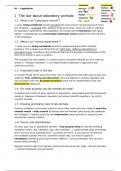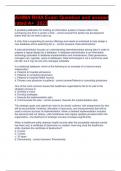Resume
VOLLEDIGE samenvatting Laboratory Animal Science
- Établissement
- Katholieke Universiteit Leuven (KU Leuven)
Dit document vat het volledige vak LAS praktisch samen. Bevat informatie uit de lesvideos (zelfstudie). Naast tekst ook figuren om alles visueel voor te kunnen stellen.
[Montrer plus]











